Advanced Lawn Care Tips for a Lush Yard
When it comes to maintaining a beautiful yard, basic lawn care practices like mowing and watering are just the beginning. To achieve a truly lush and vibrant lawn, it’s important to implement advanced lawn care techniques. These techniques go beyond the basics and require a deeper understanding of your lawn’s specific needs.
If you want to take your lawn care to the next level, consider hiring professional lawn care services. They have the expertise and knowledge to provide the best care for your lawn and help it thrive year-round. Whether it’s lawn maintenance, lawn treatment, or solving specific lawn problems, a reputable lawn care company can offer tailored solutions for your unique situation.
In this article, we will explore various advanced lawn care tips gathered from multiple sources to help you achieve the lush yard of your dreams.
Key Takeaways:
- Implementing advanced lawn care techniques is essential for a lush and vibrant yard.
- Consider hiring professional lawn care services for expert guidance and tailored solutions.
- Explore various advanced lawn care tips to elevate your lawn’s health and appearance.
- Understand the specific needs of your lawn, including maintenance, treatment, and problem-solving.
- Invest in a comprehensive lawn care program to ensure the best results.
Importance of Spring Lawn Care
Spring is a critical time for maintaining a lush and healthy lawn. As the weather starts to warm up, it’s essential to kickstart your lawn care routine to set the foundation for the rest of the growing season. By following a proper lawn care schedule and implementing key practices, you can ensure that your lawn thrives throughout the year.
Cleaning up Debris
Before diving into any other tasks, start by cleaning up any debris that accumulated over the winter. Remove fallen leaves, branches, and other debris to allow sunlight and air circulation to reach your grass. Clearing the lawn of debris also prevents diseases and pests from thriving in the decaying organic matter.
Aerating the Soil
Aerating the soil is a crucial step in spring lawn care. This process involves creating small holes in the soil to alleviate compaction and promote better airflow to the roots. By aerating your lawn, you improve the soil’s ability to absorb water, nutrients, and oxygen, which will result in healthier and stronger grass.
Fertilizing
Fertilizing your lawn in spring provides the necessary nutrients for robust growth. Choose a high-quality, slow-release fertilizer that suits your grass type and climate. This will ensure a steady and controlled release of nutrients throughout the growing season, promoting lush greenery and strong root development.
Controlling Weeds
Spring is the ideal time to tackle weed control. Apply pre-emergent herbicides to prevent weeds from germinating and taking over your lawn. Be sure to follow the instructions on the herbicide label for application rates and timing. For existing weeds, consider spot-treating with post-emergent herbicides or manually removing them to maintain a weed-free lawn.
Overseeding
If your lawn has bare or thin patches, overseeding is an effective way to promote a denser and healthier turf. Choose high-quality grass seed that matches your existing grass type and climate. Prepare the soil by raking it lightly to create a seedbed, then spread the seed evenly across the area. Water the newly seeded areas regularly to keep the soil evenly moist for optimal germination.
Lawn Care Schedule
Following a lawn care schedule is crucial to ensure that you stay on top of important tasks throughout the year. Here is a sample spring lawn care schedule to guide you:
| Task | Frequency |
|---|---|
| Cleaning up debris | Once at the beginning of spring |
| Aerating the soil | Once every 1-3 years, depending on soil compaction |
| Fertilizing | Once in early spring |
| Applying pre-emergent herbicides | Once in early spring |
| Overseeding | Once in early spring for bare spots |
By following these spring lawn care tips and adhering to a regular maintenance schedule, you can establish a strong foundation for a lush and vibrant yard. Remember to adjust your lawn care routine based on your specific grass type, climate, and local recommendations for optimal results.
Soil Testing and pH Balance
Before implementing any advanced lawn care techniques, it is essential to conduct a soil test to ensure the health and vitality of your grass. Soil pH levels can vary, impacting the availability of nutrients for your lawn. By testing the soil, you can determine the specific nutrients your grass needs and make any necessary adjustments to the pH balance.
Maintaining the correct pH balance is crucial for healthy grass growth. A pH that is too acidic or too alkaline can inhibit nutrient uptake and lead to a lackluster lawn. Regular soil testing allows you to monitor and maintain the optimal pH level, ensuring your grass receives the nutrients it requires to thrive.
“Soil testing is the foundation of effective lawn care. It provides valuable insight into the overall health and nutrient composition of your soil, guiding your lawn care practices.”
Once you have the results of your soil test, you can use the information to choose the appropriate fertilizers and soil amendments. For example, if your soil is too acidic, you may need to apply lime to raise the pH and create a more balanced environment for your grass.
Remember that different types of grass have different pH preferences, so it’s important to consider your specific grass species when interpreting the soil test results. Consulting with a lawn care professional can help you make informed decisions and develop a customized lawn care plan tailored to your grass type and soil conditions.
By prioritizing soil testing and balancing the pH levels, you will lay the foundation for a healthy and thriving lawn.
The Benefits of Soil Testing and pH Balance
- Identify nutrient deficiencies and adjust fertilization accordingly
- Prevent excessive or insufficient nutrient uptake
- Ensure optimal soil conditions for healthy and lush grass growth
- Customize your lawn care practices based on your specific soil composition
- Save time and money by avoiding unnecessary or ineffective treatments
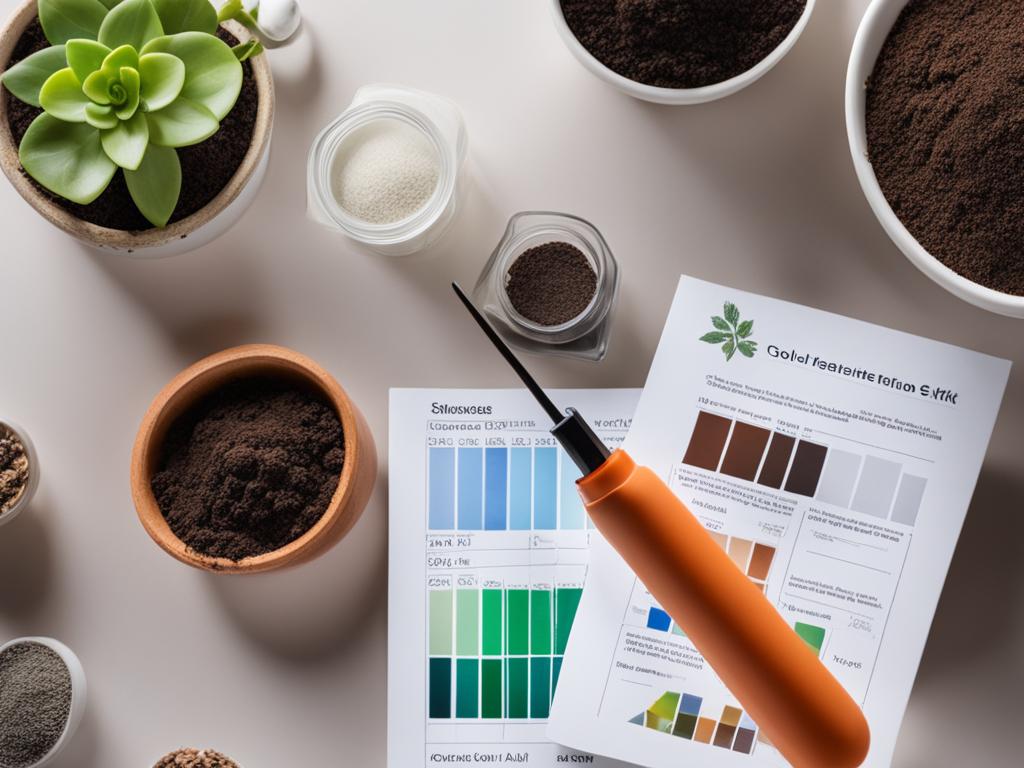
Proper Mowing Techniques
Proper mowing techniques are essential for maintaining a healthy and beautiful lawn. When done correctly, mowing not only helps your grass look lush and well-manicured but also promotes its overall health and growth. Follow these expert tips for a successful mowing routine:
- Set the Right Mower Height: Adjust your mower to the appropriate cutting height based on your grass type. Cutting too short can weaken the grass, making it more susceptible to stress, pests, and diseases.
- Avoid Cutting Too Much: Never remove more than one-third of the grass blade in a single mowing session. Cutting too much can put the grass under stress and impede its ability to recover, leading to a weak and patchy lawn.
- Mow When the Soil is Warm and Dry: Ideally, mow your lawn when the soil is warm and dried out. Mowing on wet soil can cause damage to the grass and lead to uneven cuts.
- Maintain a Regular Mowing Schedule: Regular mowing helps control weed growth and promotes a thicker, healthier lawn. Set a schedule based on your grass type and growth rate, ensuring you never let the grass become overgrown.
“Proper mowing techniques are crucial for the health and appearance of your lawn. By following these tips, you can maintain a beautiful and vibrant grass. Remember, a healthy lawn starts with a good mowing routine.”
By implementing proper mowing techniques and adhering to a regular mowing schedule, you can achieve a lush and well-maintained yard. Keep in mind that mowing is just one aspect of comprehensive lawn care. To ensure the overall health of your lawn, it’s crucial to follow a well-rounded lawn care schedule that includes fertilization, weed control, and proper watering.
Aeration for Healthy Roots
Aeration is a fundamental lawn care technique that promotes the development of healthy roots. By creating small holes in the soil, aeration allows air, water, and nutrients to penetrate the root zone, nourishing the grass from below. It is especially crucial in areas with compacted soil, which can restrict root growth and hinder the absorption of essential elements.
Compacted soil occurs when the soil particles are tightly packed together, preventing proper airflow and drainage. This can result from heavy foot traffic, construction work, or even just natural settling over time. If left untreated, compacted soil can lead to a host of problems, including poor nutrient uptake, shallow root systems, and increased susceptibility to diseases and pests.
The Benefits of Aeration
Aerating your lawn regularly offers several key benefits:
- Promotes root development: By relieving compaction, aeration encourages the growth of deep, strong roots that are better equipped to access water and nutrients.
- Enhances water infiltration: Aeration improves soil drainage, preventing water from pooling on the surface and reducing the risk of overwatering or waterlogged conditions.
- Boosts nutrient absorption: When the soil is compacted, nutrients have difficulty reaching the roots. Aeration helps create channels for nutrients and oxygen to penetrate the soil, fueling healthy growth.
- Alleviates thatch buildup: Thatch, a layer of dead grass stems and roots that accumulates on the soil surface, can impede water and air movement. Aeration breaks up thatch, speeding up its decomposition and preventing its buildup.
To determine if your lawn requires aeration, there are a few signs to look out for. If the soil feels hard or compacted, water runoff is excessive, or grass growth appears slow and thin, it’s likely time to aerate.
There are two primary methods of aeration: core aeration and spike aeration. Core aeration involves removing small plugs of soil from the ground, while spike aeration uses solid tines or spikes to create holes. Both methods can be effective, but core aeration is generally considered more thorough and beneficial for heavily compacted soils.
When aerating your lawn, it’s important to follow the proper techniques:
- Water the lawn: Aerate when the soil is slightly moist but not overly saturated. This allows the aerator to penetrate the soil effectively.
- Mark any sprinkler heads or utilities: Before starting, mark the location of any sprinkler heads or underground utilities to avoid damaging them during aeration.
- Aerate in multiple directions: For optimal results, aerate your lawn in different directions, ensuring thorough coverage and breaking up compaction effectively.
- Remove soil plugs: After aeration, leave the soil plugs on the lawn. They will break down over time, returning valuable organic matter to the soil.
- Fertilize and water: After aerating, apply fertilizers and water the lawn to replenish nutrients and support recovery.

Fertilization for Green Growth
Proper fertilization is crucial for promoting green and lush growth in your lawn. When it comes to choosing a fertilizer, opt for one that is high in nitrogen, as it supports healthy grass development. Fertilizing your lawn in the spring is especially important, as it provides essential nutrients and prevents weeds from overpowering the grass. It’s crucial to follow the recommended application rates based on your specific grass type to achieve optimal results.
If you’re unsure about which fertilizer to use or how to apply it correctly, consulting with a lawn care specialist can provide valuable guidance. They can assess your lawn’s specific needs and recommend the most suitable fertilizer and application schedule for your lawn.
To illustrate the recommended application rates for different grass types, refer to the table below:
| Grass Type | Recommended Fertilizer Application Rate |
|---|---|
| Bermuda grass | 1-2 pounds of nitrogen per 1,000 square feet |
| Zoysia grass | 1-2 pounds of nitrogen per 1,000 square feet |
| Fescue grass | 2-4 pounds of nitrogen per 1,000 square feet |
| Bluegrass | 2-4 pounds of nitrogen per 1,000 square feet |
Remember to water your lawn thoroughly after applying fertilizer to ensure proper absorption and minimize the risk of burning your grass. Implementing the right fertilization practices will significantly contribute to the overall health and beauty of your lawn.
Maintaining a Proper Watering Schedule
Consistent and proper watering is key to maintaining a healthy lawn. By following the right watering techniques, you can help your grass thrive and stay resilient. Implement the following lawn care techniques to ensure your watering schedule is on point:
- Water deeply: When you water your lawn, make sure to provide enough moisture to penetrate the soil and reach the roots. This encourages the grass to develop deep roots, making it more resilient to drought conditions.
- Water infrequently: Instead of watering every day, allow the soil to dry out between watering sessions. This prevents over-saturation and promotes healthier root growth.
- Avoid frequent light watering: Resist the temptation to water your lawn lightly on a daily basis. This can lead to shallow root growth and make your grass more susceptible to drought stress.
To determine the ideal watering schedule for your lawn, consider the specific needs of your grass type and local climate. Keep an eye on the weather forecast and adjust your watering routine accordingly. Remember, establishing a consistent and appropriate watering schedule is essential for maintaining a lush and healthy lawn.

Weed Control Strategies
Weeds can be a nuisance in any lawn, so implementing effective weed control strategies is essential for maintaining a healthy and pristine yard. By combining a variety of lawn care techniques and treatments, you can effectively combat weeds and keep your lawn looking its best. Here are some tips to help you achieve maximum weed control:
- Pre-emergent Weed Killers: Apply pre-emergent herbicides in early spring to prevent weed germination. These products create a barrier that inhibits weed seeds from sprouting, giving your lawn a head start in the battle against unwanted plants.
- Post-emergent Weed Killers: If you already have weeds in your lawn, use post-emergent herbicides to target and eliminate them. These products are designed to kill existing weeds without harming your turf. Follow the instructions carefully when applying these herbicides to ensure effective control.
- Manual Weed Removal: For a more hands-on approach, manually remove weeds by pulling them out from the root. This method is effective for isolated or small patches of weeds. Be sure to remove weeds before they mature and produce seeds to prevent further spread.
While these strategies can help control weed growth, investing in a comprehensive lawn care treatment program is often the most effective way to achieve long-term weed control. Professional lawn care companies offer a range of services and treatments that target weeds effectively and ensure the overall health of your lawn. By combining their expertise with your regular lawn maintenance routine, you can achieve a lush, weed-free yard.
Benefits of Professional Weed Control
Hiring a professional lawn care company for weed control can provide several benefits. They have the knowledge and experience to identify different weed species and apply appropriate treatments. Additionally, these experts can create a customized lawn care plan tailored to your specific needs, ensuring maximum weed control while considering the health of your grass. Professional weed control services save you time and effort, allowing you to enjoy a beautiful, weed-free lawn without the hassle of tackling this task yourself.
To illustrate the impact of professional weed control, consider the following table:
| Weed Control Methods | Effectiveness | Time Required | Expertise Required |
|---|---|---|---|
| Pre-emergent Weed Killers | High | Moderate | Low |
| Post-emergent Weed Killers | Moderate | Moderate | Low |
| Manual Weed Removal | Low | High | High |
| Professional Weed Control | High | Low | High |
As shown in the table, professional weed control offers the highest level of effectiveness with the least amount of time and expertise required. By entrusting your weed control needs to professionals, you can enjoy a weed-free lawn while saving yourself valuable time and effort.
Implementing these weed control strategies, along with other lawn care techniques, will help you achieve a healthy and vibrant yard. Remember to follow a regular lawn care schedule, including proper mowing, watering, and fertilization, to create the best conditions for your grass to thrive.
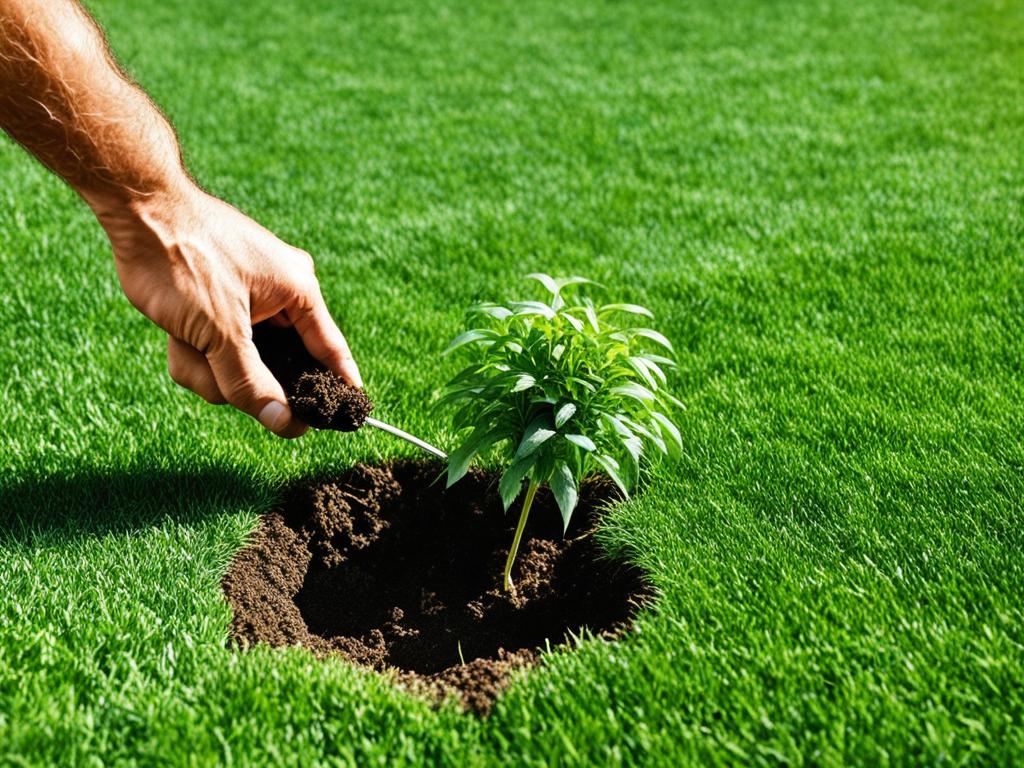
Overseeding for a Lush Lawn
Overseeding is a beneficial practice that can help revive and enhance the appearance of your lawn. By introducing new grass seed into your existing turf, you can fill in bare patches, strengthen the density of your lawn, and promote a lush and green landscape.
To ensure successful overseeding, it’s crucial to choose high-quality grass seed that is suitable for your specific grass type and climate. Different grass varieties thrive in different conditions, so selecting the right seed will contribute to the overall health and resilience of your lawn.
Tips for Successful Overseeding
- Prepare the soil: Before overseeding, it’s essential to prepare the soil properly. Remove any debris or dead grass from the area and loosen the topsoil using a rake or garden fork. This will create a receptive environment for the new seed.
- Choose the right grass seed: Select a grass seed blend or mixture that is appropriate for your lawn, considering factors such as sunlight exposure, soil type, and climate. Consult with a local garden center or lawn care professional for expert advice on the best grass seed for your specific needs.
- Follow the manufacturer’s instructions: Different grass seed varieties have varying requirements for seeding rates, depth, and watering. Carefully follow the instructions provided by the seed manufacturer to ensure proper application and optimal growth.
- Water regularly: After overseeding, it’s crucial to keep the soil consistently moist to facilitate seed germination. Water the newly seeded areas gently and frequently, ensuring that the soil doesn’t dry out. Gradually reduce watering once the new grass begins to establish.
- Avoid heavy foot traffic: During the germination process, it’s important to minimize foot traffic on the newly seeded areas. This will allow the young seedlings to take root and establish themselves without disturbance.
| Benefits of Overseeding | Points to Consider |
|---|---|
|
|
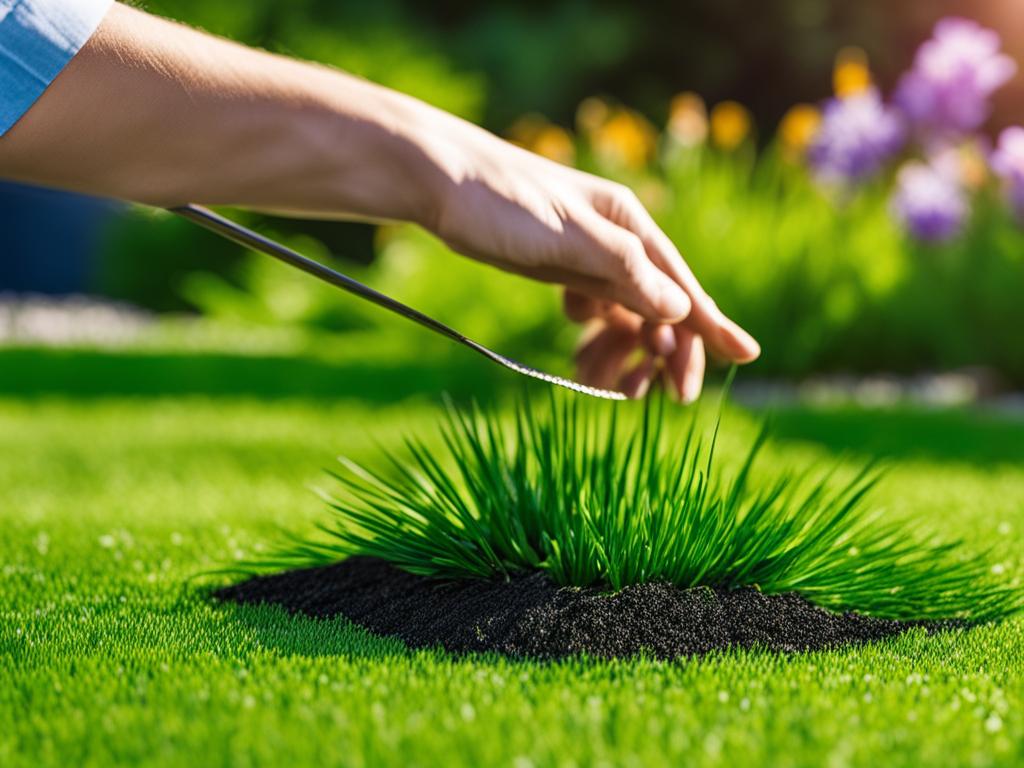
By overseeding your lawn, you can revive and rejuvenate its overall health and appearance. It’s a simple technique that can significantly improve the density, vibrancy, and resilience of your turf. Remember to choose the right grass seed, prepare the soil properly, and follow the manufacturer’s instructions for optimal results. With regular watering and proper care, your lawn will become lush, green, and the envy of the neighborhood.
Equipment Maintenance
Proper maintenance of your lawn equipment is crucial for efficient and effective lawn care. Regularly inspecting and cleaning your equipment will ensure that it is in good working condition and ready for use when needed. Additionally, taking care of your equipment will extend its lifespan, saving you time and money in the long run.
One important aspect of equipment maintenance is sharpening the mower blades. Dull blades can tear the grass instead of cutting it cleanly, resulting in an uneven and unhealthy lawn. Sharpen your mower blades regularly to promote healthy grass growth and achieve a professional-looking finish.
Here is a step-by-step guide for maintaining your lawn equipment:
- Inspect your equipment: Before each use, check for loose parts, damaged components, or any signs of wear and tear. Replace or repair any damaged parts to ensure safety and optimal performance.
- Clean your equipment: After each use, remove any grass clippings, debris, or dirt from your lawn equipment. A buildup of debris can impede the functionality of the equipment and lead to clogs or malfunctions.
- Sharpen mower blades: Sharpen your mower blades at least once or twice during the mowing season. Dull blades can damage the grass and create an uneven appearance. Follow the manufacturer’s instructions or consult a professional for guidance on blade sharpening.
- Change oil and filters: If your lawn equipment is powered by an engine, regular oil changes and filter replacements are essential for optimal performance. Consult the equipment manual for the recommended oil change frequency and filter replacement schedule.
- Check tire pressure and lubricate moving parts: Regularly inspect the tire pressure of your lawn equipment, including push mowers and tractors. Proper tire inflation ensures a smooth and even mowing experience. Lubricate any moving parts, such as wheels or hinges, to prevent rust and maintain smooth operation.
By following a regular maintenance routine for your lawn equipment, you can ensure that it operates efficiently, promotes healthy grass growth, and delivers excellent results with each use.
Quote:
“Taking care of your lawn equipment is just as important as taking care of your lawn. Regular maintenance ensures optimal performance and extends the lifespan of your equipment.” – John Smith, Professional Lawn Care Specialist
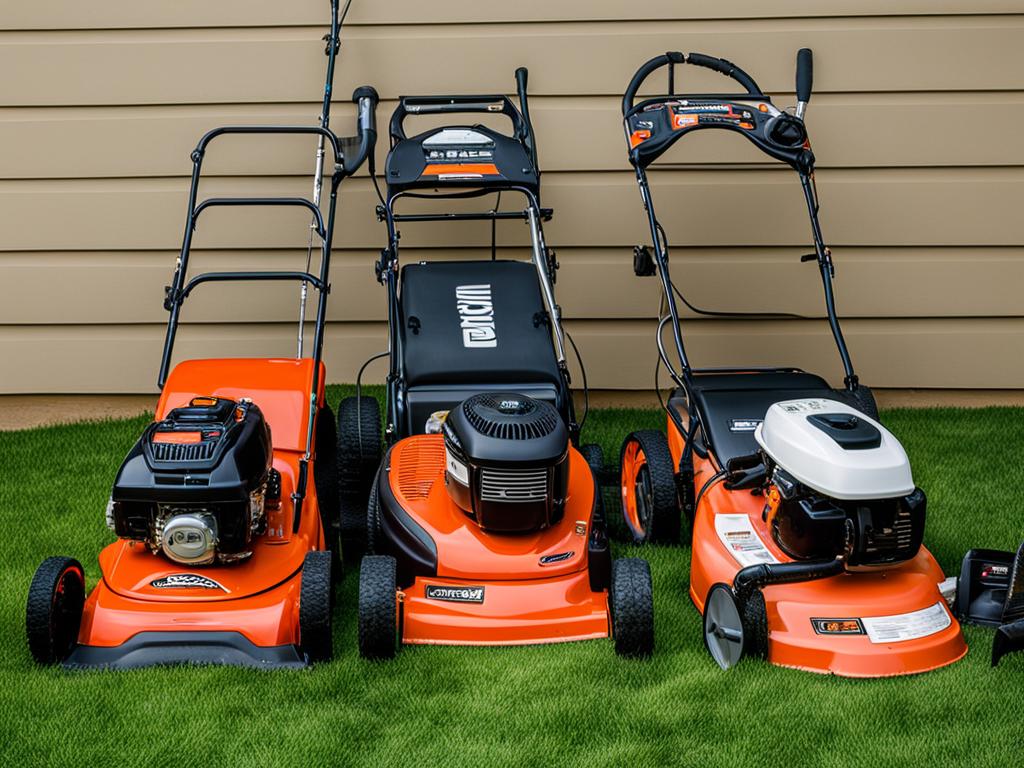
| Equipment Maintenance Checklist: |
|---|
| Inspect equipment before each use |
| Clean equipment after each use |
| Sharpen mower blades regularly |
| Change oil and filters as recommended |
| Check tire pressure and lubricate moving parts |
Summer Lawn Care Tips
Summer poses unique challenges for maintaining a vibrant and healthy lawn. The hot weather and increased foot traffic can take a toll on your grass, but with the right techniques, you can keep it looking its best. Here are some essential summer lawn care tips to help you maintain a lush and vibrant yard.
Adjust Mower Height
During the summer months, it’s best to adjust the height of your mower to a taller setting. Longer grass provides shade to the soil, helping to retain moisture and prevent weed growth. Aim to keep your grass at around 3 inches in height, as this allows the blades to absorb sunlight and promote healthy growth.
Deep and Infrequent Watering
Watering deeply but infrequently is crucial for summer lawn care. Instead of frequent, light watering, which encourages shallow root growth and makes your lawn more susceptible to drought, water your lawn deeply once or twice a week. This encourages the roots to grow deeper into the soil, making your grass more resilient to dry conditions. Remember to water early in the morning to minimize evaporation.
Treat for Pests
Summer is also the time when pests like grubs can wreak havoc on your lawn. These pests feed on the grassroots, causing brown patches and weakening the overall health of your grass. Consider treating your lawn with appropriate pest control measures to prevent infestations and keep your lawn healthy.
Avoid Parking on the Grass
During picnics or outdoor gatherings, it’s tempting to park cars on the grass. However, the weight of vehicles can compact the soil and damage the grass roots. To maintain a healthy lawn, always avoid parking on the grass and provide designated parking areas instead.
Weed Control and Regular Maintenance
Regularly inspect your lawn for weeds and address them promptly. Weeds compete with your grass for nutrients and water, hindering its growth. Use appropriate weed control methods such as hand-pulling or applying herbicides to keep your lawn weed-free. Additionally, continue regular maintenance practices such as mowing, edging, and trimming to promote healthy growth and a neat appearance.
By following these summer lawn care tips, you can ensure that your grass remains vibrant and healthy throughout the hot season. Implementing proper mowing practices, deep watering, treating for pests, avoiding parking on the grass, and maintaining regular weed control and maintenance routines will help your lawn thrive even in the summer heat.
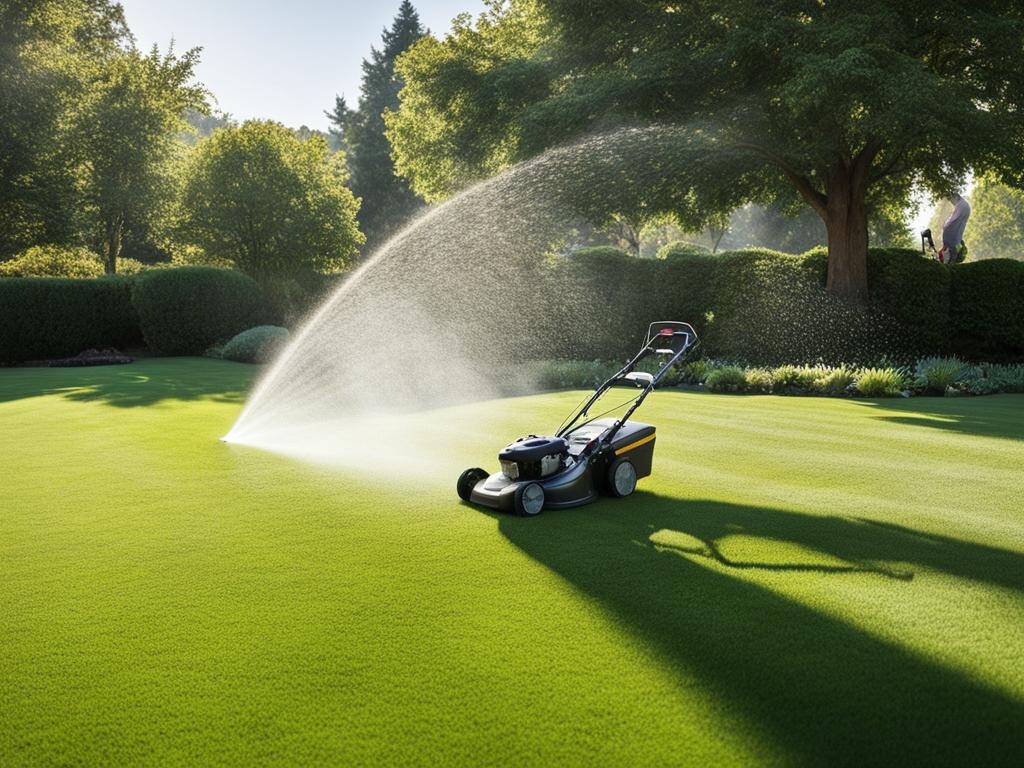
| Summer Lawn Care Tips |
|---|
| Adjust mower height to a taller setting |
| Water deeply but infrequently |
| Treat for pests like grubs |
| Avoid parking on the grass |
| Regularly control weeds and maintain the lawn |
Letting Grass Clippings Lie
If you’re mowing at the appropriate height, leaving grass clippings on the lawn can be beneficial. This practice known as grasscycling saves time, money, and serves as a natural fertilizer. The clippings break down quickly, returning nutrients to the soil and promoting healthy grass growth.
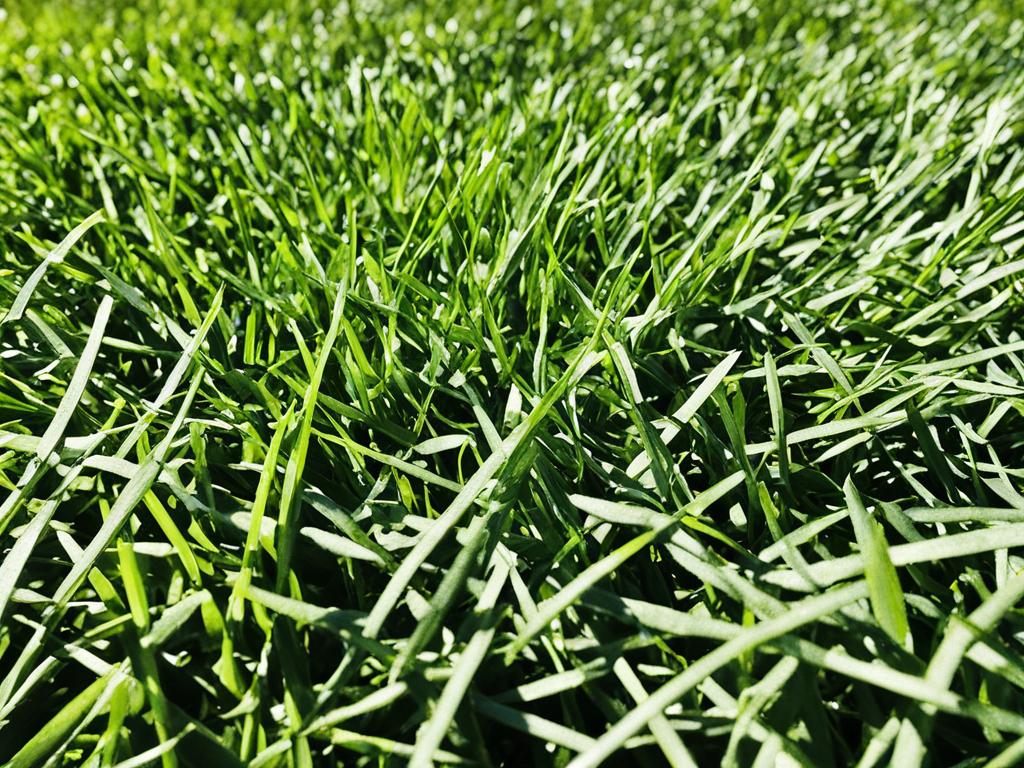
| Benefits of Grasscycling: | Why You Should Let Grass Clippings Lie |
|---|---|
| 1. Nutrient Recycling | Grass clippings contain essential nutrients, such as nitrogen, phosphorus, and potassium. When left on the lawn, these clippings decompose and release these nutrients back into the soil, providing natural fertilization for your grass. |
| 2. Moisture Retention | Leaving grass clippings on the lawn helps retain moisture by acting as a mulch layer, reducing evaporation and maintaining soil moisture levels. This can be particularly beneficial during hot and dry periods. |
| 3. Weed Suppression | A layer of grass clippings can prevent weed seeds from germinating and competing with your grass for space and resources. This natural method of weed suppression can help reduce the need for herbicides. |
| 4. Time and Effort Savings | By grasscycling, you eliminate the need to bag and dispose of grass clippings, saving you time and effort. It also reduces the amount of yard waste you generate, making it an environmentally-friendly choice. |
Proper Grasscycling Tips:
- Mow with a sharp blade: A sharp mower blade cuts the grass cleanly, preventing clumping and ensuring better decomposition of the clippings.
- Mow when the grass is dry: Wet grass clippings can clump together and create an uneven layer on the lawn. It’s best to mow when the grass is dry for optimal grasscycling results.
- Don’t overdo it: If the grass is excessively long, consider bagging some of the clippings to prevent them from smothering the grass underneath. Aim to remove no more than one-third of the grass height in a single mowing session.
By embracing grasscycling as part of your lawn care routine, you can enjoy the benefits of natural fertilization and reduce the time and effort spent on yard maintenance.
The Importance of Fertilization and Watering
When it comes to maintaining a healthy and vibrant lawn, proper fertilization and watering are crucial components of effective lawn care techniques. During the summer months, fertilizing warm-season grasses becomes even more essential as they require additional nutrients for vigorous growth and to withstand the heat.
Consulting with local lawn care experts will help you determine the appropriate fertilizer schedule for your specific region. They can provide valuable insights and recommendations based on the climate, soil conditions, and grass type in your area. By following their advice, you can ensure that your lawn receives the right amount of nutrients at the right time, promoting optimal growth and greenery.
In addition to fertilization, watering plays a critical role in maintaining a healthy lawn during hot weather. Adequate and deep watering is crucial to support seed germination and overall grass health. It is important to water your lawn deeply but infrequently, allowing the soil to dry out between watering sessions. This encourages the grass to develop deep roots, making your lawn more resilient to drought conditions.
Remember, frequent light watering can lead to shallow root growth, making your lawn more susceptible to stress and damage. By providing deep, consistent watering, you can help your grass thrive and maintain its lush appearance throughout the summer.
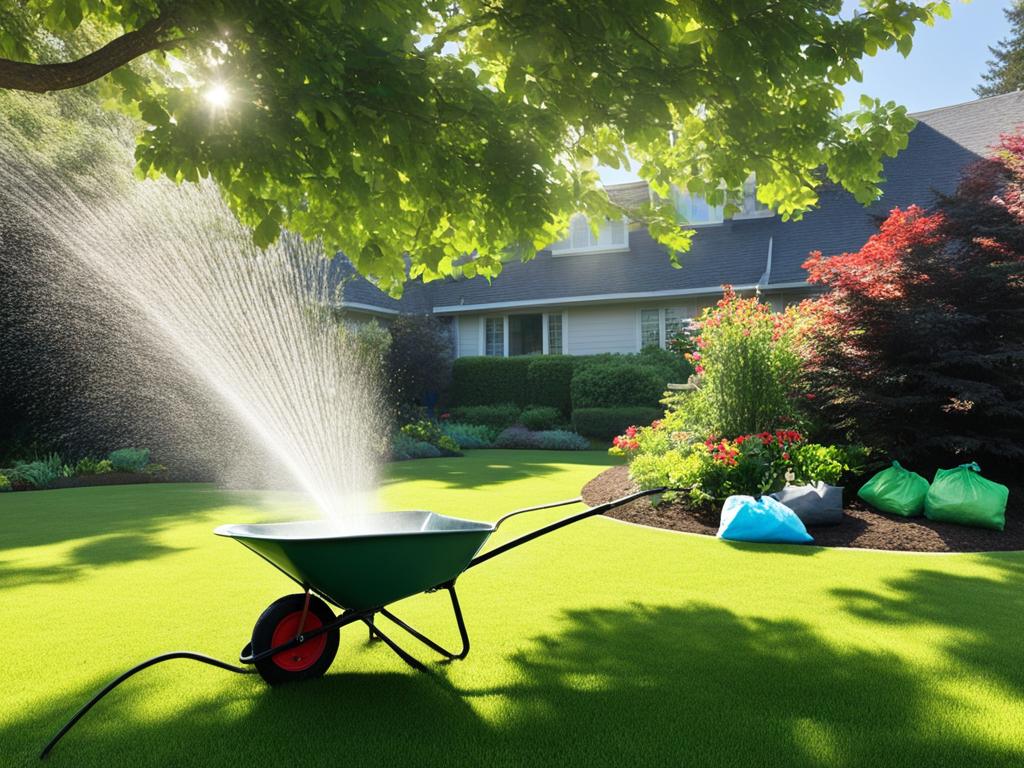
Key Points:
- Fertilizing warm-season grasses during the summer is crucial for their vigorous growth.
- Consult with local experts to determine the appropriate fertilizer schedule for your region.
- Adequate and deep watering is essential for supporting seed germination and overall grass health.
- Water your lawn deeply but infrequently, allowing the soil to dry out between watering sessions.
Conclusion
Maintaining a lush and healthy yard requires advanced lawn care techniques and regular maintenance. By implementing proper spring and summer lawn care practices, such as mowing at the right height, aerating the soil, and overseeding, you can achieve a vibrant and envy-worthy lawn.
To ensure the best results, consider consulting with professional lawn care services. Their expertise and knowledge will guide you through the process, providing personalized advice and tailored treatments for your specific lawn needs. Professional lawn care services have the necessary tools, experience, and resources to deliver exceptional results.
In addition, adopting sustainable lawn care practices is crucial for the overall health and sustainability of your lawn. Using organic fertilizers, conserving water, and implementing eco-friendly weed control methods are excellent ways to contribute to a greener and more environmentally friendly lawn. By prioritizing sustainable lawn care, you are not only enhancing the beauty of your yard, but also supporting the ecosystem and reducing your carbon footprint.
FAQ
Why is spring lawn care important?
Spring lawn care is important because it sets the foundation for a healthy lawn throughout the year. Tasks like debris cleanup, aeration, fertilization, weed control, and overseeding are crucial during this season.
Why is soil testing necessary for lawn care?
Soil testing is necessary for lawn care because it helps determine the nutrient needs and pH balance of your soil. This information allows you to provide the appropriate nutrients and adjust the pH if necessary.
What are proper mowing techniques for a healthy lawn?
Proper mowing techniques include setting the mower at the right height, avoiding cutting more than one-third of the grass blade, and mowing when the soil is warm and dry. Regular mowing and avoiding low cutting heights promote a lush lawn.
Why is aeration important for lawn care?
Aeration is important because it improves soil structure, alleviates compaction, and allows air, water, and nutrients to reach the grass roots. Regularly aerating the lawn promotes root development and reduces the risk of nutrient deficiencies.
How does fertilization contribute to lawn health?
Fertilization promotes green and lush growth by providing essential nutrients to the grass. Choosing a high-nitrogen fertilizer and following the recommended application rates for your grass type are crucial for healthy grass development.
What is the proper watering schedule for a healthy lawn?
Water deeply but infrequently, allowing the soil to dry out between watering sessions. This encourages deep root growth and makes the lawn more resilient to drought. Avoid frequent light watering to prevent shallow root growth.
How can I control weeds in my lawn?
To control weeds, consider using pre-emergent weed killers in early spring to prevent weed germination. For existing weeds, use post-emergent weed killers or remove them manually. Consult with a lawn care specialist for maximum control.
Why is overseeding beneficial for a lawn?
Overseeding helps fill in bare patches and promotes a lush lawn. Choose high-quality grass seed suitable for your grass type and climate, and water regularly after overseeding to facilitate germination and growth of the new grass.
How important is equipment maintenance for lawn care?
Equipment maintenance is crucial for efficient and effective lawn care. Regularly inspect and clean your equipment, and sharpen dull mower blades to prevent tearing and promote healthy grass growth.
What are some summer lawn care tips?
Some summer lawn care tips include adjusting the mower height to a taller setting, watering deeply and infrequently, treating for pests like grubs, and avoiding parking on the grass. Regular maintenance and weed control are also important.
Should I leave grass clippings on my lawn?
Leaving grass clippings on the lawn, a practice known as grasscycling, can be beneficial. The clippings break down quickly, returning nutrients to the soil and promoting healthy grass growth. This saves time, money, and serves as a natural fertilizer.
How important is fertilization during the summer?
Fertilizing warm-season grasses during the summer provides essential nutrients for their vigorous growth. Consult with local experts to determine the appropriate fertilizer schedule for your region. Adequate and deep watering is also crucial during hot weather to support seed germination and overall grass health.




